 |
Unichip completes the V8 big three. |
by Peter Scott
Unichip provided worthwhile (10% more power and torque) gains on my naturally aspirated 1UZ-FE Soarer.
For my V8 there were three big power upgrades. The BFI, Headers/ exhaust and finally the Unichip. My exhaust camshafts never really gave a significant gain. The Unichip intercepts the signals the engine sends the engine computer and effectively alters the timing and fuel ratio. My car was tuned on the dyno, then tuned on the road to double check that no detonation was occurring.
I am very pleased with the results. Six (6) degrees timing added, Air Fuel Ratio tuned from a rich 10.8 to 12.8 at full load. Closed loop running is not changed for AFR and oxygen sensors still do their work. Car is performing very well. Best thing I've ever done to my car? - probably yes.. Economy may have improved a whisker.
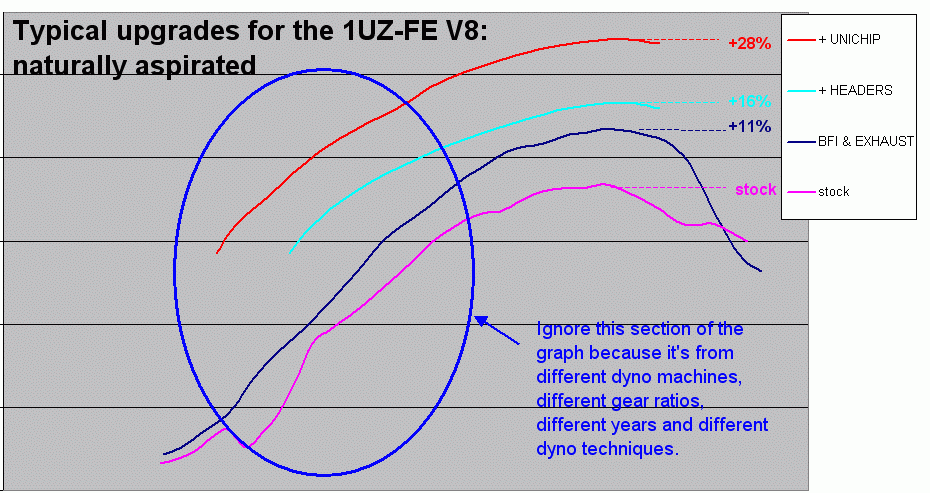
Why no power numbers etc on the graph? Well dyno graphs vary from workshop to workshop. I personally have had variances of 20 rwkW on my car. Interstate there are differences, country to country there are differences and some prefer to work in horsepower instead of kilowatts. Some like revs instead of speed down the bottom. As best as I can see, these percentages are reasonable expectations of Soarer 1UZ-FE upgrades.
If you have a stock power figure for you own car, these percentage upgrades could be expected no matter where you live on the planet. It's not the numbers that count - but the percentage improvement. I find limited valve in comparing dyno peak power figures from Soarers unless it's same day, same event, same location sort of stuff. For example in the UK and USA dyno figures are accepted to be higher than those in Australia. So not much point in converting rwkW to rwhp and comparing to another car in another place.
Whatever you stage of engine modification it can be improved to the next level and the graph above can guide you to potential gains.
Here is my before and after graph below. Again I wouldn't sweat the numbers too much - it's the improvement over the "before" case that you feel underfoot. This is with the UZZ32 suspension pump connected (not sure how much difference this makes). I have recorded a 164 rwkW on a dyno dynamics machine "before" the Unichip install, more power than this "after" graph - but a few V8's were running high numbers that day. As an example 10% improvement on my previous 164 gives 180 rwkW. I wish rwkW was rwkW where ever it was measured but it really doesn't appear to be the case.
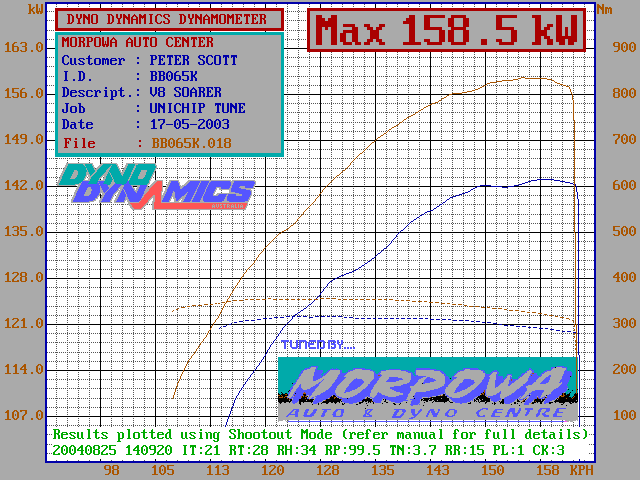
I got an approximate 10.5 % improvement with a Unichip.
Benny Gammelmark got at 10.6 % improvement with a Unichip
as well. How's that for consistency? Both of us have BFI#3s and Headers.
I know that on that first graph up the top it looks like I got a 12% improvement (16%
to 28%), but those percentages are compared to a stock value of 123 rwkW, not a before
value of 143 odd rwkW.
Cost was $1300 Aud install and tune. Well worth it for me. It's the only way I could find to have my car tuned for fuel and timing on a dyno and on the road with engine microphones. I wanted it professionally tuned
Dyno dynamics (common in Aust) machines read on average 12% lower than a Dynojet
machine common in USA. I have read this in several references including one workshop
with both machines installed.
I was going to go the Microtech route. But I didn't want to give up my fuel economy during cruise, and the million hours Toyota spent doing a multitude of maps for the stock ecu. For the same price I got as much power as any stand alone ECU could give and kept all the best bits from the Toyota ECU.
I also like that when the supercharger and larger injectors (same impedance) go on I can retune to suit.
Another feature I'll be using is the "LPG switch" feature. A simple switch can retune the car for LPG with a retuned timing map. I don't intend to run LPG, but I can use the same feature to tune the car for higher boost one day, or running rocket fuel occasionally.
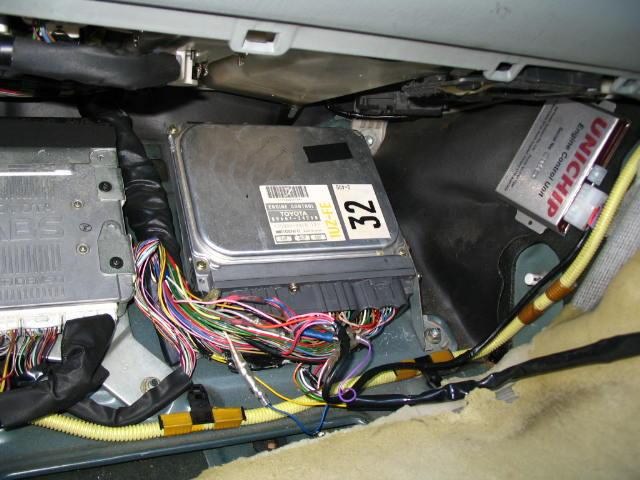
Unichip mounted on transmission tunnel of my car.
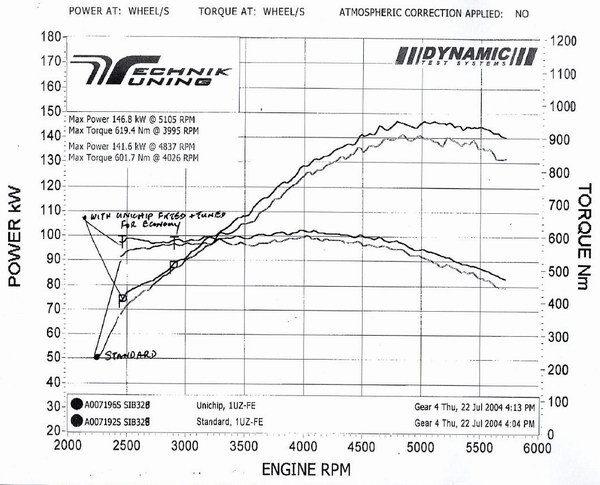
This is a Unichip install on a stock V8 Soarer with stock airbox and stock exhaust. Gary specifically asked for economy only tune - not peak power. He is keeping his car stock and does a lot miles each week. He is very happy with his improved economy.
Here is an excerpt from the UniChip site:
http://www.airpowersystems.com.au/unichip/dyno/toyota/soarerv8.html
The V8 Soarer comes to life with optimized fuel and ignition. Significant gains are
made throughout the RPM range with improvements in outright acceleration, driveability and
throttle response.
The Unichip not only enhances power and torque across all throttle positions throughout
the entire rev range, but significantly enhances throttle response, driveability, fuel
economy and outright acceleration.
I'm blasting around everywhere - especially off the line - I've had such a lazy car
for so long I'm really enjoying the new lease on life the car has.
At Mallala race track I had to relearn a couple of corners and shift points. The
Start-Finish straight was what I noticed the most, even with street tyres limiting drive
out of the corner - my speed at the end of straight was averaging 10-13 km/hr faster, (130
ish with slicks to 145 ish with street tyres). I couple of times I found my self braking
thinking "I don't usually brake here!"
P. Scott
Please Note: The Unichip is available from Air Power Systems in Australia and New Zealand
only. For other regions, please contact Dastek.
by David Vaughan Friday, April 29, 2005
I fitted a Unichip but in different circumstances from others I have seen, and the results are interesting. It shows a gain of 14.4 rwkw or 10.9%, very consistent with results achieved by other people. Here is the graph.
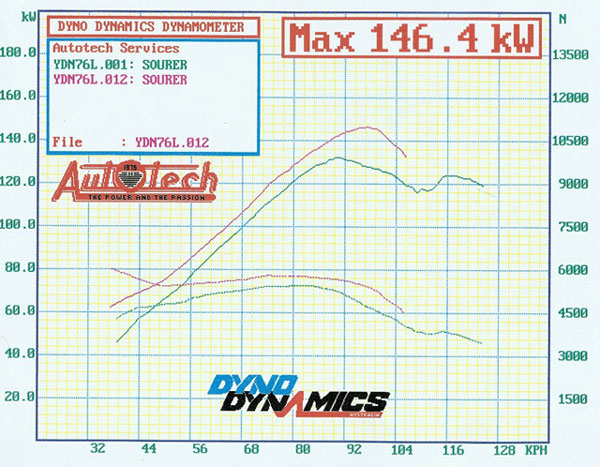
Look at the speed indicator on the bottom
of the graph. This was in 2nd gear, about 20km/h/1000rpm. Before the Unichip, the engine
was peaking around 4500rpm and after at barely 5000. The engine can not rev out with
power. I think this may be because it is strangled by lack of airflow. If you have another
theory about it, perhaps to do with fuelling or mapping, please suggest it here.
I have a BFI 3 so it is not starved at the intake but, in my thinking, choked at the
exhaust. Previous writers have all done the exhaust before the Unichip and not seen this
effect. The answer to this is fairly obvious - get headers and improve the airflow through
the exhaust. Another answer is to V8 owners with standard intake and outlet systems. If
you are accelerating hard then taking it over 5000 revs wastes petrol, wears the motor and
does not really help you go any faster ![]() .
.
Despite this peak problem, I am very happy with the results so far. As another writer
said, it is like adding a BFI 3 only more so. The car accelerates more easily throughout
the range. It climbs faster out of roundabouts or away from the lights and feels as though
it has more reserve all the time. It is also a bit louder, which is hardly surprising. If
you are getting bigger, brighter and better explosions in the cylinders and the exhaust is
doing the same work it always did, there will be more noise left over at the back end. To
a small degree you get this effect just with the BFI.
In Canberra, this work was done by Autotech Alfa (ask for Peter Dowling) who used to
service my Alfa back in the 70s (Alfa: nice to drive, not so nice to own).
by
A UK first: Unichip fitted to UZZ31 V8 Soarer
Well, I finally did
it and the results are extremely encouraging.
Those of you who follow the V8 modification scene may be aware that over the last few
months Peter Scott has successfully used a Unichip on his UZZ32 Active to realise 10.5%
gains (see the original article at http://www.planetsoarer.com/unichip/unichip.htm).
I decided that this was also an excellent upgrade for me personally, as I plan to use a
supercharger and possibly NOS in the future, both of which are supported by the unichip (www.daskek.co.uk).
There are a number of unichip dealers located around the country (around 50), Dastek can
advise you on which is closest - and calling around may enable you to get a better price.
I decided to use PTS who are based in Luton, as they did a good job on my racelogic
traction control system on a previous occasion. PTS installed and adjusted the ingnition
timing (between 1 and 4 degrees) and managed to increase BHP by approximately 6 bhp.
Recording power on an automatic is always difficult to do, and dyno output varies
massively between garages.
PTS didn't adjust the fuelling which surprised me, they said based on the CO2 sensor
output no adjustments were required, howver I wasn't convinced. So I took the car to
Millway Vehicles Specialists in Andover, Hampshire for a second opinion. Sure enough they
found that adjusting the AFR from 11.5 to 12.4 throught the rev range eeked out even more
power. The dyno graph from this run is attached below:
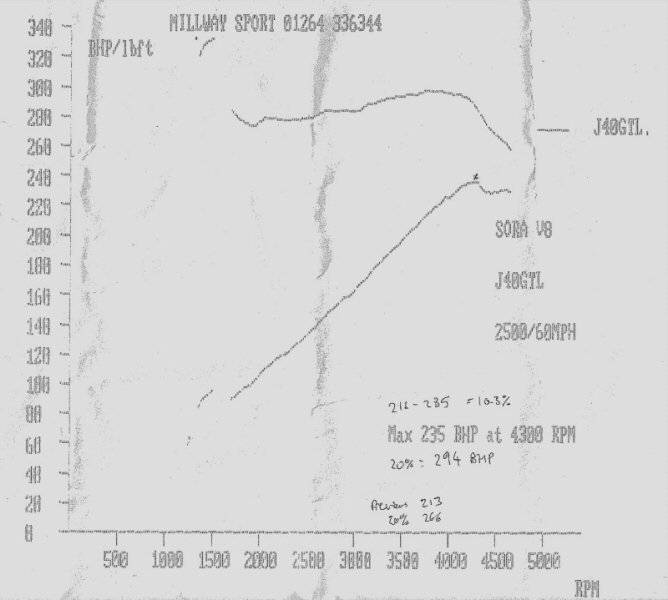
Summary of results:
Max Power 235 Rear Wheel Horse Power (RWHP)
Estimated Flywheel (20% trans loss): 294 BHP
Max Torque 303 lb/ft
Timing (advanced) 1-4deg.
AFR: Increased from 11.5 to 12
I was really happy with the results. With headers, BFI and exhaust the car read 212rwhp.
So the increase to 235rwhp is roughly 10.8%, broadly in line with the results Peter Scott
and others have realised on their V8s. However its important to realise the 212 dyno was
done at Thor on a portable dyno, Millway on rollers. Its not terribly accurate to compare
the two but as a rough indication its in line with expectations.
Driveability
The affect is similar to the headers really, only slightly more pronounced. Throttle
response is now much quicker, giving the illusion of a lighter car. kickdown and double
kickdown really snap your neck back and shove you in your seat, a sensation TT owners will
be more familiar with than your stock V8 owner. Acceleration is greater and especially
noticeable in the low and mid range. The car is now even more fun to drive and certainly
has more punch. The engine note is even more crisper now, and I hope to see an improvement
in fuel consumption.
Conclusions
This is a highly recommended upgrade. I am extremely dissapointed with PTS that they
didn't take the time to trim the fuelling, making me make another visit and invest further
cash in tuning. I wouldn't recommend PTS to do your install, my gut feeling is they rushed
me off the dyno to get more customers in. Fortunately Millway were excellent, and highly
recommend. Their engineers were friendly and knowledgeable, I felt I got a much better
service from them. Millway charge £470 + vat for unichip install and tune.
On the basis of this run, the "big three" V8 upgrades as Pete refers to them as,
have gained me around 34 bhp, at an investment of around £1000. But don't forget
horsepower should never be the absolute metric, I have had massive torque gains and big
driveability improvements too. The car is now performing better than ever, and I'm
confident I now have a firm platform for the big one, an M90 supercharger.
Contacts
Millway Vehicle Specialists
47, Royce Close, Andover, Hampshire SP10 3TS
Tel: 01264 336344 (ask for Jay)
<click here for map>